Adjusting jointer knives
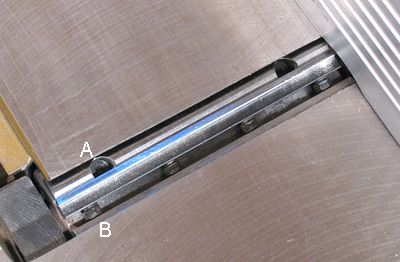 There are two designs of cutter heads in terms of how
the knives are adjusted. The type pictured at left is with jack screws (A)
behind the blades, which are used to lift the blades to the right height.
There are two designs of cutter heads in terms of how
the knives are adjusted. The type pictured at left is with jack screws (A)
behind the blades, which are used to lift the blades to the right height.
Another set of screws, seen from the side (B) are used to clamp the
blades in place. The heads of these screws push against the head, pressing the
bar against the blades. The blades are held in just by friction.
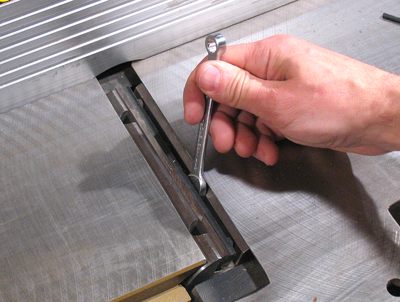 To remove the blades, start by loosening the four screws holding the bar in.
This is done with a small wrench. Pushing the wrench away from you loosens the screws.
Turn them until they are loose, and perhaps a half a turn further. Not loosening them
too far makes reinstalling them easier.
To remove the blades, start by loosening the four screws holding the bar in.
This is done with a small wrench. Pushing the wrench away from you loosens the screws.
Turn them until they are loose, and perhaps a half a turn further. Not loosening them
too far makes reinstalling them easier.
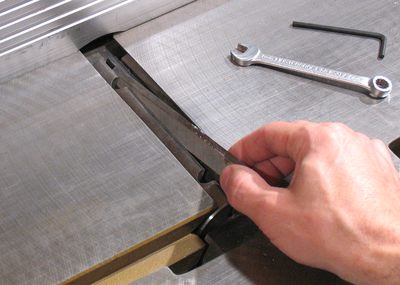 With all four screws loosened, the knife can be pulled out. It's easier to remove
the knife before removing the bar, as the slot is wider towards the bottom, and the
screws would have to be loosened more for the bar to come out first.
With all four screws loosened, the knife can be pulled out. It's easier to remove
the knife before removing the bar, as the slot is wider towards the bottom, and the
screws would have to be loosened more for the bar to come out first.
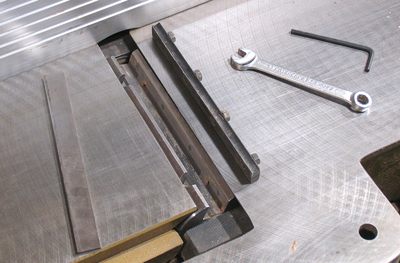 After removing the knife, the bar lifts out easily. The next step is to clean out
the slot, so that any dust in there won't affect the alignment when you
reinstall the knives.
After removing the knife, the bar lifts out easily. The next step is to clean out
the slot, so that any dust in there won't affect the alignment when you
reinstall the knives.
Once you have the knives out, presumably, you want the knives to get them sharpened.
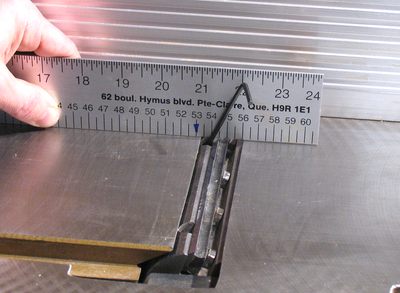 Once you have your knives back from sharpening, it's time to put them back in.
Put the bar in first, then the knife. Next, tighten the four screws in the bar, and
then back them off a bit so that they make contact but aren't tight.
Once you have your knives back from sharpening, it's time to put them back in.
Put the bar in first, then the knife. Next, tighten the four screws in the bar, and
then back them off a bit so that they make contact but aren't tight.
Use a straightedge resting on the outfeed table to check the height. With an alan
key in the jack screw, and the straight edge right next to it, set the height of the
knifes so that they just touch the ruler at the highest point.
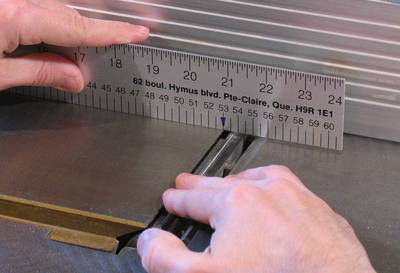
Set the height of the knives so that if you rest the ruler on the outfeed table, and turn the planer head by hand, it will pick up the ruler, and move it forward by 5 mm, or about 0.2". Measure it just above the jack screws. It's a bit of an iterative process, and I usually just leave the alan key in between checking.
For a typical 2.5" diameter cutter head on a 6" jointer, having the
ruler be moved by 5 mm works out to having the knives protrude 0.004" (0.1mm) above
the outfeed table. However, once you tighten the four screws to lock the blade in
place, the knife will actually come up a little bit, just from flexing in the
steel. On my jointer, after tightening, the ruler gets carried about 6 mm, which works
out to closer to about .0048" or 0.12 mm. When you adjust the blades, ignore this
change in height after tightening. After installing, adjusting and tightening
all three blades, check that they all come to the same height.
If they all came up by the same height after tightening, you are good to go.
The amount of protrusion from how much the ruler gets carried can be calculated as follows
If r is the radius (not diameter) of the cutter head, and d is the distance
the ruler is carried, then the protrusion (p) of the knives from the outfeed
table can be calculated using the
Pythagorean theorem.
For a right angled triangle, the pythagorean theorem states that the sum of the squares
of the length of the sides forming a right angle is equal to the square of the length
of the diagonal.
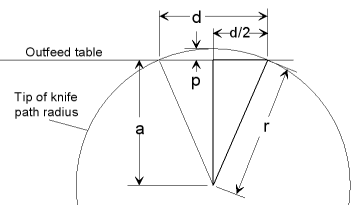
Thus, for the geometry at right, a2 + (d/2)2 = r2
and a can be calculated as a = sqrt(r2-(d/2)2)
Where sqrt denotes square root.
And finally, p = r - a
Thus:
Protrusion p = r-sqrt(r2-(d/2)2)
For a 2.5" diameter cutter head, using inches, this works out as follows:
| Distance ruler pulled | Knife Protrusion | ||||||||||||||
|---|---|---|---|---|---|---|---|---|---|---|---|---|---|---|---|
Setting knives on a springs-backed knife style cutter head
The other type of planer head has no jack screws, but some springs behind the knives. This type of head is also used in most thickness planers.
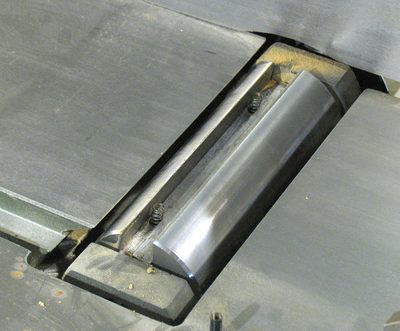
 Rather than a pair of jack screws, the jointer blades are pushed up two little
springs.
Rather than a pair of jack screws, the jointer blades are pushed up two little
springs.
On this type of cutter head, the blades are set in place using a jig. Thickness planers generally also use this approach, as there is no outfeed table to measure the blades from.
When you take the blade and the bar out, you might as well loosen the screws by
several turns, as getting the blade and bar back in against the spring tension
is very fiddly.
Also, ifthe springs are loose, take them out and put them aside, so they
won't fall out at the bottom when you turn the cutter head.
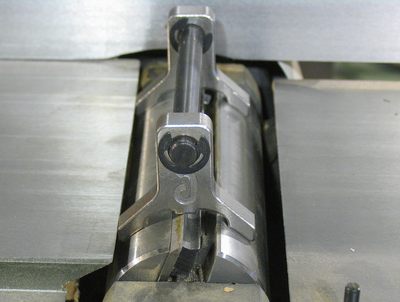 Your jointer should have come with a jig something like the one at left.
To use the jig, crank the infeed and outfeed tables down a bit to make room for it.
Your jointer should have come with a jig something like the one at left.
To use the jig, crank the infeed and outfeed tables down a bit to make room for it.
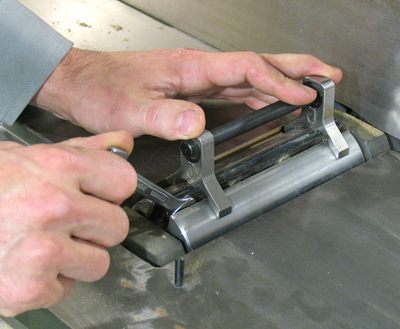
To set the knives, tighten and then back off the four screws holding the bar in place like you would with the head that uses jack screws. It should be possible to push the knife down, and have it come back up from the force of the springs.
While pressing the jig firmly down on the knife, tighten the screws. Really, just one screw tightened towards either end will do it. The screws are a bit hard to reach while the jig is in place.
Once you have all the blades set, wind the outfeed table back up, then adjust it so that the tips of the blades will drag a straightedge by about 5 mm, as described above. Hopefully, all the blades will be at a consistent height. If not, it's possible that you slipped with the jig while tightening the blade, so use the jig to check if any of your blades are set too high.
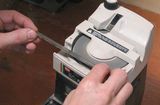 Sharpening jointer knives
Sharpening jointer knives(freehand)
To my Woodworking website
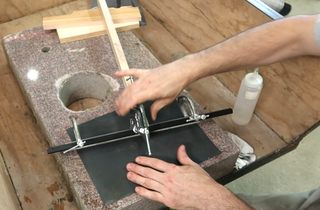 Sharpening jointer knives straight
Sharpening jointer knives straight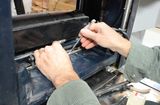 Changing planer knives
Changing planer knives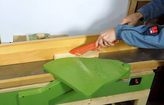 Does wood glue
Does wood glue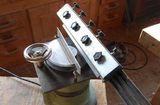 Planer blade sharpening machine
Planer blade sharpening machine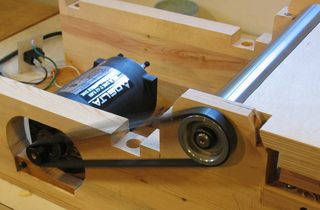 Homemade jointer
Homemade jointer